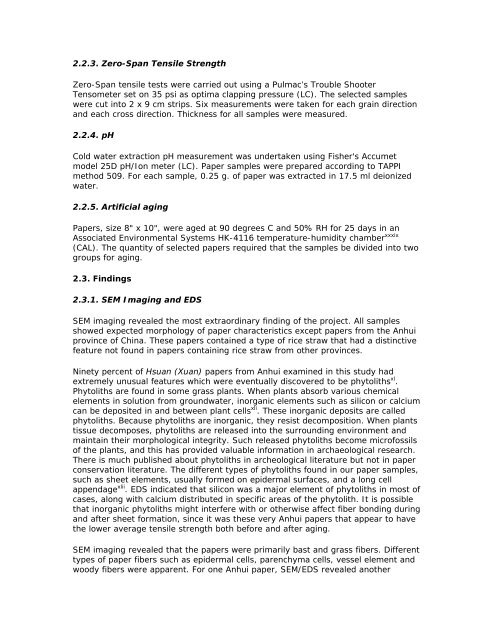technology, treatment, and care of a chinese wood block print
technology, treatment, and care of a chinese wood block print
technology, treatment, and care of a chinese wood block print
You also want an ePaper? Increase the reach of your titles
YUMPU automatically turns print PDFs into web optimized ePapers that Google loves.
2.2.3. Zero-Span Tensile Strength<br />
Zero-Span tensile tests were carried out using a Pulmac’s Trouble Shooter<br />
Tensometer set on 35 psi as optima clapping pressure (LC). The selected samples<br />
were cut into 2 x 9 cm strips. Six measurements were taken for each grain direction<br />
<strong>and</strong> each cross direction. Thickness for all samples were measured.<br />
2.2.4. pH<br />
Cold water extraction pH measurement was undertaken using Fisher's Accumet<br />
model 25D pH/Ion meter (LC). Paper samples were prepared according to TAPPI<br />
method 509. For each sample, 0.25 g. <strong>of</strong> paper was extracted in 17.5 ml deionized<br />
water.<br />
2.2.5. Artificial aging<br />
Papers, size 8" x 10", were aged at 90 degrees C <strong>and</strong> 50% RH for 25 days in an<br />
Associated Environmental Systems HK-4116 temperature-humidity chamber xxxix<br />
(CAL). The quantity <strong>of</strong> selected papers required that the samples be divided into two<br />
groups for aging.<br />
2.3. Findings<br />
2.3.1. SEM Imaging <strong>and</strong> EDS<br />
SEM imaging revealed the most extraordinary finding <strong>of</strong> the project. All samples<br />
showed expected morphology <strong>of</strong> paper characteristics except papers from the Anhui<br />
province <strong>of</strong> China. These papers contained a type <strong>of</strong> rice straw that had a distinctive<br />
feature not found in papers containing rice straw from other provinces.<br />
Ninety percent <strong>of</strong> Hsuan (Xuan) papers from Anhui examined in this study had<br />
extremely unusual features which were eventually discovered to be phytoliths xl .<br />
Phytoliths are found in some grass plants. When plants absorb various chemical<br />
elements in solution from groundwater, inorganic elements such as silicon or calcium<br />
can be deposited in <strong>and</strong> between plant cells xli . These inorganic deposits are called<br />
phytoliths. Because phytoliths are inorganic, they resist decomposition. When plants<br />
tissue decomposes, phytoliths are released into the surrounding environment <strong>and</strong><br />
maintain their morphological integrity. Such released phytoliths become micr<strong>of</strong>ossils<br />
<strong>of</strong> the plants, <strong>and</strong> this has provided valuable information in archaeological research.<br />
There is much published about phytoliths in archeological literature but not in paper<br />
conservation literature. The different types <strong>of</strong> phytoliths found in our paper samples,<br />
such as sheet elements, usually formed on epidermal surfaces, <strong>and</strong> a long cell<br />
appendage xlii . EDS indicated that silicon was a major element <strong>of</strong> phytoliths in most <strong>of</strong><br />
cases, along with calcium distributed in specific areas <strong>of</strong> the phytolith. It is possible<br />
that inorganic phytoliths might interfere with or otherwise affect fiber bonding during<br />
<strong>and</strong> after sheet formation, since it was these very Anhui papers that appear to have<br />
the lower average tensile strength both before <strong>and</strong> after aging.<br />
SEM imaging revealed that the papers were primarily bast <strong>and</strong> grass fibers. Different<br />
types <strong>of</strong> paper fibers such as epidermal cells, parenchyma cells, vessel element <strong>and</strong><br />
<strong>wood</strong>y fibers were apparent. For one Anhui paper, SEM/EDS revealed another
















